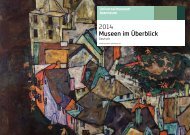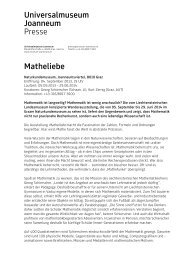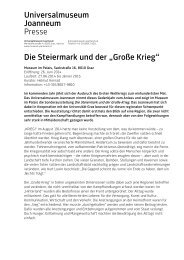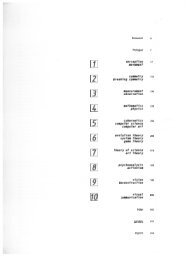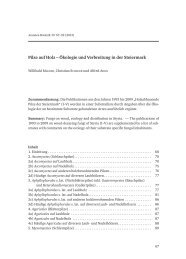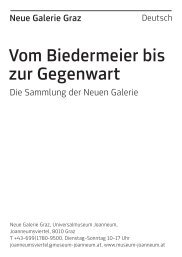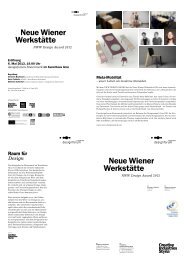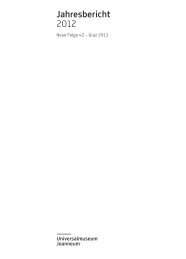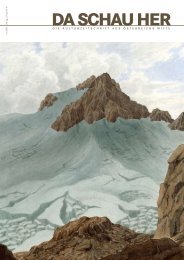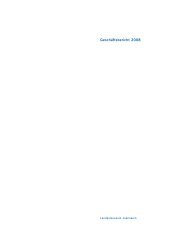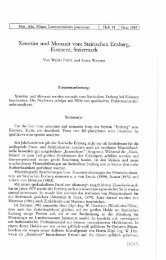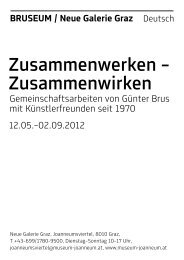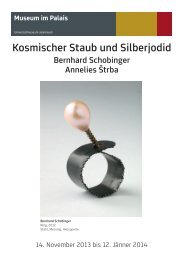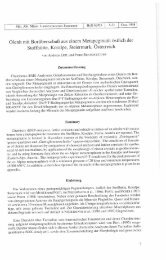Diana Thater gorillagorillagorilla - Universalmuseum Joanneum
Diana Thater gorillagorillagorilla - Universalmuseum Joanneum
Diana Thater gorillagorillagorilla - Universalmuseum Joanneum
Erfolgreiche ePaper selbst erstellen
Machen Sie aus Ihren PDF Publikationen ein blätterbares Flipbook mit unserer einzigartigen Google optimierten e-Paper Software.
Distanz umgeben. Es geht nicht um echte Tiere, um jene tierischen<br />
anderen, die sich auf den ersten Seiten der Genesis um die<br />
ersten Menschen scharten und bei ihren Namen gerufen wurden.<br />
Die Perspektive, die uns eröffnet wird, ist eine menschliche, die<br />
Geschichte, um die es hier geht, ist die der Menschheit selbst.<br />
Auch wenn im Untertitel des Buches der Mensch und das Tier<br />
nebeneinander präsentiert werden, verlagert sich die Geschichte,<br />
die in Das Offene erzählt wird, von einer Beziehung zwischen<br />
dem Menschen und den Tieren zu einer zwischen dem Menschen<br />
und dem Tier und gelangt letztendlich zu einer Spaltung, die im<br />
Inneren des Menschen selbst verortet ist. Der Mensch wird sich<br />
an der äußersten Grenze seiner Geschichte mit „seiner tierischen<br />
Natur“ aussöhnen. Die ganze Geschichte wird eine Geschichte<br />
des Menschen gewesen sein, eine Geschichte, die auf einem<br />
Konflikt zwischen dem Menschen und dieser Natur beruht, die<br />
der Mensch ausschließen oder leugnen muss, um überhaupt<br />
Mensch zu sein. Die Geschichte der Menschheit ist nichts andres<br />
als diese Geschichte, als dieser Ausschluss des Tierischen aus<br />
ihrer eigenen Selbstdefinition, als Grundbedingung dafür, dass sie<br />
ihre Berufung findet. Das Ende dieses messianischen Geschichtsentwurfs<br />
würde gemäß Agambens ursprünglicher Interpretation<br />
des Bildes die Form eines Friedens annehmen, eines neuen und<br />
„gerechten“ Verhältnisses zwischen Mensch und Tier.<br />
Wir können uns natürlich über die Dürftigkeit dieser Ausgangsformulierung<br />
beklagen. Agambens Ablehnung von Zofia<br />
Ameisenowas ikonografischer Analyse ist von etwas gefolgt, das<br />
fast schon wie eine Binsenweisheit klingt: Tiernatur, Versöhnung.<br />
Uns fehlt etwas. Der gesamte thematische Bogen des Buches<br />
spannt sich dann um die langsame Ausarbeitung von Agambens<br />
Interpretation dieses Bildes. Erst im allerletzten Absatz des<br />
Buches offenbart man uns das Wesen dieser im ersten Kapitel<br />
ausgesprochenen Verheißung einer Versöhnung. Wir erfahren,<br />
dass das Bildnis der Gerechten mit den Tierköpfen keine „neue<br />
Deklination im Verhältnis zwischen Tier und Mensch“ darstellt.<br />
Die Mehrzahl der Kapitel, die dieser Diskussion des Bildes<br />
aus der illuminierten Handschrift folgen, stellen verschiedene<br />
Momente innerhalb dieser „Deklination“ (einer Reihe von Permutationen<br />
ein und desselben gewalttätigen Verhältnisses) dar,<br />
sei das nun eine Betrachtung der Trennung des Begriffes<br />
„Leben“ in Aristoteles’ Anima (Kapitel 4), der taxonomischen<br />
Aporien von Carl von Linnés anthropomorphen Lebewesen<br />
(Kapitel 7 und 8) oder der besonderen Eigenschaften der minimalistischen<br />
Welt der Zecke, wie sie Jakob von Uexküll, der<br />
große Verhaltensforscher des 20. Jahrhunderts, aufgeführt hat<br />
(Kapitel 10 und 11).4 Wir werden zu der Annahme geführt,<br />
life that surround humanity in varying relations of<br />
proximity and distance. It will not be a question<br />
of real animals, of those animal others that in the first<br />
pages of Genesis gathered round the first humans<br />
and were called by their names. The perspective we<br />
are given is a human one, the history proposed that of<br />
humanity itself. If the subtitle of the book presents<br />
“Man and Animal” side-by-side, the story The Open<br />
tells slips from a relation between man and animals to<br />
man and the animal to, finally, a cleavage internal to<br />
the human itself. Man will, at the extreme edge of his<br />
history, be reconciled with “his animal nature”. All of<br />
history will have been human history, a history constituted<br />
by a conflict between the human and this nature<br />
that the human must exclude or disavow in order to<br />
be human at all. Humanity is nothing other than this<br />
history, this exclusion of animal life from its own selfidentification,<br />
as the condition for its own coming into<br />
its own. The conclusion of this messianic scheme of<br />
history would, according to Agamben’s initial reading<br />
of the image, assume the form of a peace, a new, “just”<br />
relation between man and animal.<br />
We can lament the poverty of this initial formulation.<br />
Agamben’s rejection of the iconographical analysis<br />
offered by Ameisenowa is followed by what is almost<br />
a platitude: animal nature, reconciliation. We are left<br />
wanting. The entire arc of the book will be the slow<br />
working out of Agamben’s interpretation of this image.<br />
It is only when we arrive at the book’s final paragraph<br />
that the nature of this reconciliation promised in the first<br />
chapter is revealed. We are told that the image of the<br />
just depicted with the heads of animals does not represent<br />
a “new declension of the man-animal relation”. The<br />
majority of the chapters following this discussion of the<br />
image from the illuminated manuscript represent different<br />
moments within this “declension” (a set of permutations<br />
of a single and same violent relation), whether it<br />
be a consideration of the division of the notion of “life”<br />
in Aristotle’s De Anima (chapter 4), the taxonomic aporias<br />
of Linnaeus’ anthropomorphs (chapters 7 and 8), or<br />
the specific features of the minimalist world of the tick<br />
enumerated by the great 20th century ethologist Jakob<br />
von Uexküll (chapters 10 and 11).4 To propose a new<br />
declension of this relation would, we are led to believe,<br />
amount to reinscribing this relation between man and



